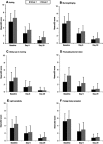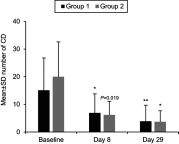Improvement in ocular symptoms and signs in patients with Demodex anterior blepharitis using a novel terpinen-4-ol (2.5%) and hyaluronic acid (0.2%) cleansing wipe
- PMID: 31417235
- PMCID: PMC6592021
- DOI: 10.2147/OPTH.S198585
Improvement in ocular symptoms and signs in patients with Demodex anterior blepharitis using a novel terpinen-4-ol (2.5%) and hyaluronic acid (0.2%) cleansing wipe
Abstract
Purpose: To evaluate the clinical improvement in ocular symptoms and signs in patients suffering from Demodex anterior blepharitis after using a novel cleansing wipe impregnated with 2.5% terpinen-4-ol and 0.2% hyaluronic acid. Study design: This was an exploratory, multicenter, open, randomized, two-parallel group comparative study. Methods: Forty-eight patients with Demodex anterior blepharitis were randomly assigned to apply the sterile wipe T1172 (Blephademodex®), either once daily (n=24, Group 1) or twice daily (n=24, Group 2) for 29 days. Overall ocular discomfort and other individual symptoms were measured using a 0-10 numeric rating scale at Day 8 and Day 29. Ocular signs, including eyelid margin hyperemia and number of cylindrical dandruff, were examined at slit lamp. Overall treatment performance by investigator, patient satisfaction and tolerance were evaluated with questionnaires. Results: Overall ocular discomfort was significantly reduced from baseline (p<0.0001) in both groups at Day 8 (-3.6±0.3 in Group 1 and -4.0±0.4 in Group 2) and Day 29 (-5.7±0.4 and -6.8±0.7, respectively), with no difference between groups (D8: p=0.718; D29: p=0.505). Each ocular symptom associated with Demodex blepharitis was improved in both groups. Eyelid margin hyperemia was significantly reduced at Day 8 (-0.7±0.7; p<0.001) and Day 29 (-1.1±0.7; p<0.0001) in Group 1. Similar results were observed in Group 2 (Day 8: p<0.001; Day 29: p<0.0001). Total disappearance of cylindrical dandruff was reported in 30.4% of patients in Group 1 and 43.5% in Group 2. Improvements in other ocular signs were observed in both groups. The product was well tolerated. All patients were satisfied or very satisfied and would continue using it. Conclusion: Daily eyelid hygiene using this cleansing wipe impregnated with 2.5% terpinen-4-ol and 0.2% hyaluronic acid during a 4-week period led to a rapid and marked reduction in ocular symptoms and signs associated with Demodex anterior blepharitis and was well tolerated.
Keywords: Demodex; blepharitis; cleansing wipe; eyelid hygiene; hyaluronic acid; terpinen-4-ol.
Conflict of interest statement
MK and SD are consultants for Laboratoires Théa. SD reports personal fees from Alcon-Novartis, Bausch&Lomb, Horus, Santen, and Théa, outside the submitted work. The authors report no other conflicts of interest in this work.
Figures






References
-
- Gao -Y-Y, Di Pascuale MA, Li W, et al. High prevalence of Demodex in eyelashes with cylindrical dandruff. Invest Ophthalmol Vis Sci. 2005;46(9):3089–3094. - PubMed
LinkOut - more resources
Full Text Sources

